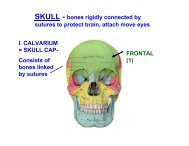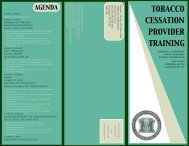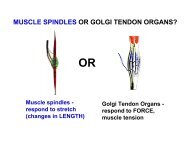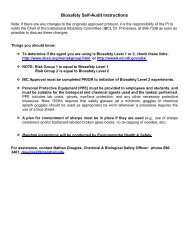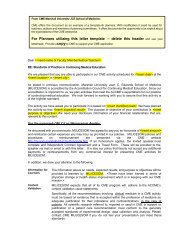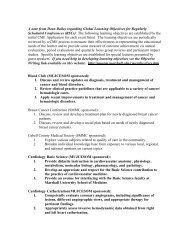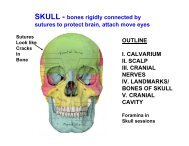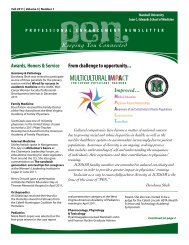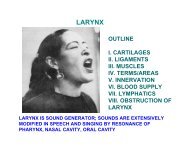FA 5 Progress Report WV-INBRE - Joan C. Edwards School of ...
FA 5 Progress Report WV-INBRE - Joan C. Edwards School of ...
FA 5 Progress Report WV-INBRE - Joan C. Edwards School of ...
- No tags were found...
You also want an ePaper? Increase the reach of your titles
YUMPU automatically turns print PDFs into web optimized ePapers that Google loves.
Program Director/Principal Investigator (Last, First, Middle): Rankin, Gary O 44PI3K, AKT AND ERR-ALPHA PATHWAYS IN FLAVONOID-INHIBITING TUMORIGENESIS(0032)TYPE:Research Subproject%IDeA $: 4.000% IDeA $: 125,000INVESTIGATOR, DEGREEChen, Yi C PHDLuo, Haitao PHDRojanasakul, Yon PHDDEPARTMENTBiologyBiologyBaic PharmaceuticalSciencesNON-HOST INSTITUTION: STATE,COUNTRYAlderson-Broaddus College, Wv UsaAlderson-Broaddus College, Wv UsaWest Virginia University, Wv UsaTotal # human subjects expected for entire study: 0Total # human subjects enrolled to date: 0SUBPROJECT DESCRIPTIONIn this study, we tend to expand our understanding on the effect <strong>of</strong> flavonoid kaempferol and how kaempferolregulates VEGF expression and angiogenesis in ovarian cancer cells. We timed VEGF secretion, andstudied in-vitro angiogenesis by kaempferol treatment. Gene expression was examined by qRT-PCR,ELISA, Western Blotting, or luciferase assay, and pathways were examined by manipulating geneticcomponents with plasmid or siRNA transfection. It was found that kaempferol time-dependently inhibitedVEGF secretion, and suppressed in-vitro angiogenesis. Kaempferol down-regulated ERK phosphorelationas well as NFkappaB and cMyc expression, but promoted p21 expression. Examination <strong>of</strong> relationshipbetween these genes suggested a novel ERK-NFkappaB-cMyc-p21-VEGF pathway, which accounts forkaempferol’s angioprevention effects in ovarian cancer cells. These data supplements our comprehension<strong>of</strong> the mechanisms behind kaempferol’s biological influence in ovarian cancer cells, and bettercharacterized kaempferol toward chemoprevention.SUBPROJECT PROGRESSWe have successfully completed these specific aims proposed in our previous proposal.Aim 1. Identify the roles and molecular mechanisms <strong>of</strong> flavonoids in inhibiting EGFR, PI3K, AKT,and ERRα in ovarian cancer cells. We found that the flavonoid kaempferol inhibited PI3K/AKT,and ERRα regulated VEGF expression in ovarian cancer cells. We published our results inpeer-reviewed scientific journals.Aim 2. Determine flavonoid-inhibiting signaling pathways that affect ovarian tumor growth. Wefound that both HIF dependent (PI3K/AKT) pathway and HIF independent (ERRα and cMyc)pathways were involved in the ovarian tumor growth inhibition. We published our results inpeer-reviewed scientific journals.Aim 3. Determine whether kaempferol inhibit ovarian tumor angiogenesis, and identify whichsignaling molecules mediate kaempferol-inhibiting tumor angiogenesis. We found that kaempferolinhibit ovarian tumor angiogenesis through inhibiting HIF-1α, VEGF, cMyc and ERRα signalingmolecules. We published our results in peer-reviewed scientific journals.PROTECTION AGAINST RESEARCH RISKSN 1. Will human subjects be involved next year?N 2. Will vertebrate animals be used next year?N 3. Will recombinant DNA experiment(s) be conducted next year?N 4. Are there potential hazards to laboratory workers (carcinogens, pathogens, ionizing radiation, etc.)involved in the proposed research for next year? If yes, identify:N5. Will any <strong>of</strong> the research-risk categories,not involved next year, be involved future years? If yes, identify:PHS 2590 (Rev. 06/09)Continuation Format Page



